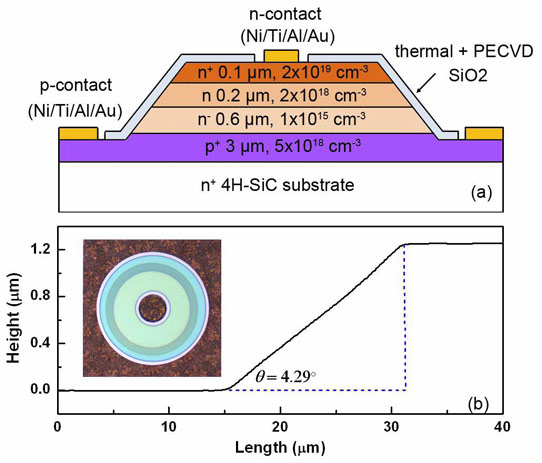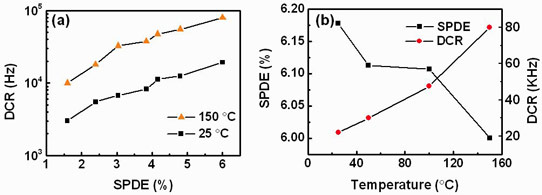- News
2 June 2014
Improving single photon counting at high temperature with silicon carbide
China’s Nanjing University has produced silicon carbide (SiC) avalanche photodiodes (APDs) with the lowest claimed dark count rate (DCR) at high temperatures of 150°C, compared with any other semiconductor material [Dong Zhou et al, IEEE Photonics Technology Letters, vol26, p1136, 2014].
According to the researchers, such devices could find a number of applications, including flame detection on battle fields or in gas turbines, and gamma-ray detection for down-hole gas and oil exploration. Ultraviolet detection is also important for space missions where minimum cooling budget and footprint calls for devices such as compact SiC APDs.
APDs are operated near the reverse-bias breakdown region so that incoming photons cause an avalanche of electrons. Such ‘Geiger mode’ operation can even be used to detect single photons with high gain. However, a low dark count rate is needed to separate the photon signal from noise.
The researchers deposited the device layers (Figure 1) on an n-type 4H polytype SiC substrate from SiCrystal AG.

Figure 1: (a) Schematic cross-section of 4H-SiC APD, (b) profile of beveled mesa characterized by stylus profilometer; inset: top view of fabricated APD.
The fabrication consisted of inductively coupled plasma etch of the mesa, passivation with 15nm thermal oxidation and 185nm plasma enhanced chemical vapor deposition (PECVD) of silicon dioxide, opening of contact windows with a wet etch, and electron-beam evaporation and rapid thermal annealing of the metal electrodes.
The mesa was beveled to suppress edge breakdown with a shallow 4.29° slope angle using a photoresist reflow technique.
At room temperature, the device has an abrupt breakdown at 186V bias. Below 174V, the dark current is below the floor of the measurement set up – i.e. less than 0.1pA. The gain at 190V is around 2x106, where unity gain is defined to be that at 10V bias. At unity gain bias, the response curve peaked at 290nm and cut off at ~380nm, corresponding to the 4H-SiC bandgap of 3.26eV. The maximum external quantum efficiency was estimated at 53.4%.
Raising the temperature to 175°C increases the dark current before breakdown by more than three orders of magnitude. The researchers believe that the increased dark current is related to residual surface defects. The unity gain bias spectral response increased at the longer wavelengths with temperature, giving a maximum external quantum efficiency of 63.3% at 295nm in a 150°C environment. The red-shift in response is attributed to bandgap narrowing with increased temperature. The breakdown voltage increases approximately linearly with temperature at a rate of 14mV/°C.
Single photon counting was carried out with the device biased near breakdown and with the avalanche current quenched by a load resistor. Electrical pulses were detected with a high-speed oscilloscope put in parallel with a sampling resistor. The source was a 22pW 280nm ultraviolet LED delivering ~3x107 photons per second.
The single photon detection efficiency (SPDE) can be increased by varying the applied bias, but at the expense of an increased dark count rate (DCR) (Figure 2a). The SPDE decreases with temperature from 6.17% to 6.00% between room temperature and 150°C at a fixed gain of 1.3x106 (Figure 2b). At the higher temperature, the DCR was 80kHz, giving a normalized DCR of 7.1Hz/μm2.

Figure 2: (a) DCR versus SPDE at 25°C and 150°C; (b) SPDE and DCR versus temperature.
The researchers comment: “Such low high-temperature DCR has never been achieved in APDs based on other semiconductor materials. The equivalent UV radiation density is ∼5pW/mm2 at 280nm.”
http://ieeexplore.ieee.org/xpl/login.jsp?tp=&arnumber=6787024
The author Mike Cooke is a freelance technology journalist who has worked in the semiconductor and advanced technology sectors since 1997.


